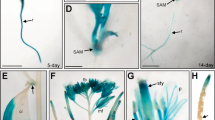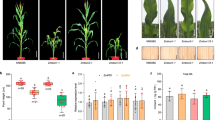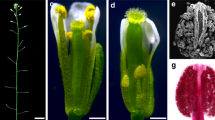Abstract
Plant development requires coordination among complex signaling networks to enhance the plant's adaptation to changing environments. DELLAs, transcription regulators originally identified as repressors of phytohormone gibberellin signaling, play a central role in integrating multiple signaling activities via direct protein interactions with key transcription factors. Here, we found that DELLA is mono-O-fucosylated by the novel O-fucosyltransferase SPINDLY (SPY) in Arabidopsis thaliana. O-fucosylation activates DELLA by promoting its interaction with key regulators in brassinosteroid- and light-signaling pathways, including BRASSINAZOLE-RESISTANT1 (BZR1), PHYTOCHROME-INTERACTING-FACTOR3 (PIF3) and PIF4. Moreover, spy mutants displayed elevated responses to gibberellin and brassinosteroid, and increased expression of common target genes of DELLAs, BZR1 and PIFs. Our study revealed that SPY-dependent protein O-fucosylation plays a key role in regulating plant development. This finding may have broader importance because SPY orthologs are conserved in prokaryotes and eukaryotes, thus suggesting that intracellular O-fucosylation may regulate a wide range of biological processes in diverse organisms.
This is a preview of subscription content, access via your institution
Access options
Access Nature and 54 other Nature Portfolio journals
Get Nature+, our best-value online-access subscription
$29.99 / 30 days
cancel any time
Subscribe to this journal
Receive 12 print issues and online access
$259.00 per year
only $21.58 per issue
Buy this article
- Purchase on Springer Link
- Instant access to full article PDF
Prices may be subject to local taxes which are calculated during checkout






Similar content being viewed by others
Accession codes
References
Vert, G. & Chory, J. Crosstalk in cellular signaling: background noise or the real thing? Dev. Cell 21, 985–991 (2011).
Silverstone, A.L., Ciampaglio, C.N. & Sun, T. The Arabidopsis RGA gene encodes a transcriptional regulator repressing the gibberellin signal transduction pathway. Plant Cell 10, 155–169 (1998).
Peng, J. et al. The Arabidopsis GAI gene defines a signaling pathway that negatively regulates gibberellin responses. Genes Dev. 11, 3194–3205 (1997).
Sun, T.P. The molecular mechanism and evolution of the GA-GID1-DELLA signaling module in plants. Curr. Biol. 21, R338–R345 (2011).
Davière, J.M. & Achard, P. Gibberellin signaling in plants. Development 140, 1147–1151 (2013).
de Lucas, M. et al. A molecular framework for light and gibberellin control of cell elongation. Nature 451, 480–484 (2008).
Feng, S. et al. Coordinated regulation of Arabidopsis thaliana development by light and gibberellins. Nature 451, 475–479 (2008).
Xu, H., Liu, Q., Yao, T. & Fu, X. Shedding light on integrative GA signaling. Curr. Opin. Plant Biol. 21, 89–95 (2014).
Ueguchi-Tanaka, M. et al. GIBBERELLIN INSENSITIVE DWARF1 encodes a soluble receptor for gibberellin. Nature 437, 693–698 (2005).
Murase, K., Hirano, Y., Sun, T.P. & Hakoshima, T. Gibberellin-induced DELLA recognition by the gibberellin receptor GID1. Nature 456, 459–463 (2008).
McGinnis, K.M. et al. The Arabidopsis SLEEPY1 gene encodes a putative F-box subunit of an SCF E3 ubiquitin ligase. Plant Cell 15, 1120–1130 (2003).
Sasaki, A. et al. Accumulation of phosphorylated repressor for gibberellin signaling in an F-box mutant. Science 299, 1896–1898 (2003).
Griffiths, J. et al. Genetic characterization and functional analysis of the GID1 gibberellin receptors in Arabidopsis. Plant Cell 18, 3399–3414 (2006).
Dill, A., Jung, H.-S. & Sun, T.P. The DELLA motif is essential for gibberellin-induced degradation of RGA. Proc. Natl. Acad. Sci. USA 98, 14162–14167 (2001).
Silverstone, A.L. et al. Functional analysis of SPINDLY in gibberellin signaling in Arabidopsis. Plant Physiol. 143, 987–1000 (2007).
Wilson, R.N. & Somerville, C.R. Phenotypic suppression of the gibberellin-insensitive mutant (gai) of Arabidopsis. Plant Physiol. 108, 495–502 (1995).
Olszewski, N.E., West, C.M., Sassi, S.O. & Hartweck, L.M. O-GlcNAc protein modification in plants: evolution and function. Biochim. Biophys. Acta 1800, 49–56 (2010).
Hartweck, L.M., Scott, C.L. & Olszewski, N.E. Two O-linked N-acetylglucosamine transferase genes of Arabidopsis thaliana L. Heynh. have overlapping functions necessary for gamete and seed development. Genetics 161, 1279–1291 (2002).
Jacobsen, S.E., Binkowski, K.A. & Olszewski, N.E. SPINDLY, a tetratricopeptide repeat protein involved in gibberellin signal transduction in Arabidopsis. Proc. Natl. Acad. Sci. USA 93, 9292–9296 (1996).
Zentella, R. et al. O-GlcNAcylation of master growth repressor DELLA by SECRET AGENT modulates multiple signaling pathways in Arabidopsis. Genes Dev. 30, 164–176 (2016).
Jacobsen, S.E. & Olszewski, N.E. Mutations at the SPINDLY locus of Arabidopsis alter gibberellin signal transduction. Plant Cell 5, 887–896 (1993).
Luther, K.B. & Haltiwanger, R.S. Role of unusual O-glycans in intercellular signaling. Int. J. Biochem. Cell Biol. 41, 1011–1024 (2009).
Okajima, T. & Irvine, K.D. Regulation of notch signaling by O-linked fucose. Cell 111, 893–904 (2002).
Hofsteenge, J. et al. C-mannosylation and O-fucosylation of the thrombospondin type 1 module. J. Biol. Chem. 276, 6485–6498 (2001).
Lira-Navarrete, E. et al. Structural insights into the mechanism of protein O-fucosylation. PLoS One 6, e25365 (2011).
Chen, C.I. et al. Structure of human POFUT2: insights into thrombospondin type 1 repeat fold and O-fucosylation. EMBO J. 31, 3183–3197 (2012).
Lazarus, M.B., Nam, Y., Jiang, J., Sliz, P. & Walker, S. Structure of human O-GlcNAc transferase and its complex with a peptide substrate. Nature 469, 564–567 (2011).
Kreppel, L.K. & Hart, G.W. Regulation of a cytosolic and nuclear O-GlcNAc transferase: role of the tetratricopeptide repeats. J. Biol. Chem. 274, 32015–32022 (1999).
Wu, Z.L., Ethen, C.M., Prather, B., Machacek, M. & Jiang, W. Universal phosphatase-coupled glycosyltransferase assay. Glycobiology 21, 727–733 (2011).
Baykov, A.A., Evtushenko, O.A. & Avaeva, S.M. A malachite green procedure for orthophosphate determination and its use in alkaline phosphatase-based enzyme immunoassay. Anal. Biochem. 171, 266–270 (1988).
Lazarus, M.B. et al. HCF-1 is cleaved in the active site of O-GlcNAc transferase. Science 342, 1235–1239 (2013).
Schimpl, M. et al. O-GlcNAc transferase invokes nucleotide sugar pyrophosphate participation in catalysis. Nat. Chem. Biol. 8, 969–974 (2012).
Martinez-Fleites, C. et al. Structure of an O-GlcNAc transferase homolog provides insight into intracellular glycosylation. Nat. Struct. Mol. Biol. 15, 764–765 (2008).
Bai, M.Y. et al. Brassinosteroid, gibberellin, and phytochrome impinge on a common transcription module in Arabidopsis. Nat. Cell Biol. 14, 810–817 (2012).
Oh, E. et al. Cell elongation is regulated through a central circuit of interacting transcription factors in the Arabidopsis hypocotyl. eLife 3, e03031 (2014).
Gallego-Bartolomé, J. et al. Molecular mechanism for the interaction between gibberellin and brassinosteroid signaling pathways in Arabidopsis. Proc. Natl. Acad. Sci. USA 109, 13446–13451 (2012).
Nozue, K. et al. Rhythmic growth explained by coincidence between internal and external cues. Nature 448, 358–361 (2007).
Soy, J. et al. Phytochrome-imposed oscillations in PIF3 protein abundance regulate hypocotyl growth under diurnal light/dark conditions in Arabidopsis. Plant J. 71, 390–401 (2012).
Silverstone, A.L., Mak, P.Y.A., Martínez, E.C. & Sun, T.P. The new RGA locus encodes a negative regulator of gibberellin response in Arabidopsis thaliana. Genetics 146, 1087–1099 (1997).
Hart, G.W., Slawson, C., Ramirez-Correa, G. & Lagerlof, O. Cross talk between O-GlcNAcylation and phosphorylation: roles in signaling, transcription, and chronic disease. Annu. Rev. Biochem. 80, 825–858 (2011).
Bond, M.R. & Hanover, J.A. A little sugar goes a long way: the cell biology of O-GlcNAc. J. Cell Biol. 208, 869–880 (2015).
Greenboim-Wainberg, Y. et al. Cross talk between gibberellin and cytokinin: the Arabidopsis GA response inhibitor SPINDLY plays a positive role in cytokinin signaling. Plant Cell 17, 92–102 (2005).
Tseng, T.S., Salomé, P.A., McClung, C.R. & Olszewski, N.E. SPINDLY and GIGANTEA interact and act in Arabidopsis thaliana pathways involved in light responses, flowering, and rhythms in cotyledon movements. Plant Cell 16, 1550–1563 (2004).
Zentella, R. et al. Global analysis of DELLA direct targets in early gibberellin signaling in Arabidopsis. Plant Cell 19, 3037–3057 (2007).
Earley, K.W. et al. Gateway-compatible vectors for plant functional genomics and proteomics. Plant J. 45, 616–629 (2006).
Dill, A., Thomas, S.G., Hu, J., Steber, C.M. & Sun, T.P. The Arabidopsis F-box protein SLEEPY1 targets gibberellin signaling repressors for gibberellin-induced degradation. Plant Cell 16, 1392–1405 (2004).
Zhang, Z.L. et al. Scarecrow-like 3 promotes gibberellin signaling by antagonizing master growth repressor DELLA in Arabidopsis. Proc. Natl. Acad. Sci. USA 108, 2160–2165 (2011).
Silverstone, A.L. et al. Repressing a repressor: gibberellin-induced rapid reduction of the RGA protein in Arabidopsis. Plant Cell 13, 1555–1566 (2001).
Swain, S.M., Tseng, T.S., Thornton, T.M., Gopalraj, M. & Olszewski, N.E. SPINDLY is a nuclear-localized repressor of gibberellin signal transduction expressed throughout the plant. Plant Physiol. 129, 605–615 (2002).
Udeshi, N.D., Compton, P.D., Shabanowitz, J., Hunt, D.F. & Rose, K.L. Methods for analyzing peptides and proteins on a chromatographic timescale by electron-transfer dissociation mass spectrometry. Nat. Protoc. 3, 1709–1717 (2008).
Berk, J.M. et al. O-linked β-N-acetylglucosamine (O-GlcNAc) regulates emerin binding to barrier to autointegration factor (BAF) in a chromatin- and lamin B-enriched “niche”. J. Biol. Chem. 288, 30192–30209 (2013).
Xu, Y., Strickland, E.C. & Fitzgerald, M.C. Thermodynamic analysis of protein folding and stability using a tryptophan modification protocol. Anal. Chem. 86, 7041–7048 (2014).
Arnold, K., Bordoli, L., Kopp, J. & Schwede, T. The SWISS-MODEL workspace: a web-based environment for protein structure homology modelling. Bioinformatics 22, 195–201 (2006).
Biasini, M. et al. SWISS-MODEL: modelling protein tertiary and quaternary structure using evolutionary information. Nucleic Acids Res. 42, W252–W258 (2014).
Acknowledgements
We thank C. Toleman for assistance with in vitro enzyme assays and G. Dubay at Duke Chemistry Instrument Facilities for help with the MALDI–MS analysis. We also thank Z.-M. Pei and J. Siedow for helpful comments on the manuscript. This work was supported by the National Institutes of Health (R01 GM100051 to T.-p.S.; R01 GM037537 to D.F.H.), the National Science Foundation (MCB-0923723 to T.-p.S.; MCB-0516690, MCB-0820666 and MCB-1158089 to N.E.O.), the Department of Energy (DE-SC0014077 to T.-p.S.) and the US Department of Agriculture (2014-67013-21548 to T.-p.S.).
Author information
Authors and Affiliations
Contributions
R.Z., N.S. and T.-p.S. conceived and designed the research project. R.Z., N.S., W.-P.H. and J.H. performed molecular biology and biochemical analysis; R.Z., N.S., P.Z. and T.-p.S. analyzed data. B.B. performed LC–ETD–MS/MS analysis, and B.B., J.S. and D.F.H. analyzed MS data. P.Z. also provided advice on protein purification and structure modeling. M.B. provided reagents and advice for in vitro enzyme assays with MALDI–MS; N.E.O. provided experimental materials and shared unpublished results. R.Z., N.S. and T.-p.S. wrote the manuscript.
Corresponding author
Ethics declarations
Competing interests
The authors declare no competing financial interests.
Supplementary information
Supplementary Text and Figures
Supplementary Results, Supplementary Figures 1–12, Supplementary Tables 1 and 2, and Supplementary Notes 1–5 (PDF 11443 kb)
Rights and permissions
About this article
Cite this article
Zentella, R., Sui, N., Barnhill, B. et al. The Arabidopsis O-fucosyltransferase SPINDLY activates nuclear growth repressor DELLA. Nat Chem Biol 13, 479–485 (2017). https://doi.org/10.1038/nchembio.2320
Received:
Accepted:
Published:
Issue Date:
DOI: https://doi.org/10.1038/nchembio.2320
This article is cited by
-
A population genomics analysis of the Aotearoa New Zealand endemic rewarewa tree (Knightia excelsa)
npj Biodiversity (2024)
-
O-glycosylation of the transcription factor SPATULA promotes style development in Arabidopsis
Nature Plants (2024)
-
The master growth regulator DELLA binding to histone H2A is essential for DELLA-mediated global transcription regulation
Nature Plants (2023)
-
Structure and dynamics of the Arabidopsis O-fucosyltransferase SPINDLY
Nature Communications (2023)
-
Structural insights into mechanism and specificity of the plant protein O-fucosyltransferase SPINDLY
Nature Communications (2022)



